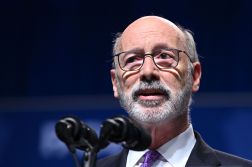Minnesota Legislature battles over broadband grant funding, criteria

Minnesota lawmakers are running out of time to come to an agreement on how to fund the state’s broadband grants program, and what internet speed standards they should set for the program’s applicants.
Members from the House and Senate are hammering out a compromise between the starkly different proposals in each chamber before the end of the legislative session Monday. At issue is how much money to allocate for the state’s “Border-to-Border Broadband Grant Program,” which hands out funds for private providers and co-ops to expand high-speed internet access throughout Minnesota, and what criteria the state’s Office of Broadband Development should set for those grants.
Earlier this year, Gov. Mark Dayton called on lawmakers to use the state’s substantial budget surplus to invest at least $100 million in broadband expansion efforts, though there’s now fierce disagreement about whether that amount is appropriate.
State Sen. Matt Schmit led a group of senators in crafting legislation that would allocate $85 million for the program in the 2017 fiscal year, and expand the definitions of areas considered “unserved” and “underserved” by broadband providers in the state.
The broadband office gives priority to applicants hoping to build networks in “unserved” areas, which Schmit’s bill would redefine as regions that lack access to speeds of at least 25 megabits per second for downloads and 3 Mbps for uploads. Similarly, his legislation would also alter the definition of “underserved” areas to mean places where people don’t have access to at least 100 megabits per second download speeds and 20 Mbps upload speeds — the state currently defines those areas as ones with access to between 10 and 20 Mbps for downloads and five to 10 Mbps for uploads.
“We have increasing bandwidth needs for all sorts of applications in our daily life, so we need to be thinking forward,” Schmit told StateScoop. “We want to target resources in the hardest-to-serve areas, but also make it possible for applicants and communities to come to our Office of Broadband Development with some ideas about serving broader areas and make investments for the long haul.”
By contrast, the House included language in a broader budget bill to allocate $40 million for the program over the next two fiscal years. Additionally, the proposal would change the “unserved” definition to speeds of 10 Mbps for downloads and 3 Mbps for uploads, and the “underserved” criteria to 25 Mbps for downloads and 3 Mbps for uploads.
“We owe it to the residents of our unserved and underserved areas to provide the internet connection they need to keep pace with the Twin Cities,” state Rep. Ron Kresha, one of the prime authors of the bill’s broadband language, wrote in a statement.
Kresha also said he thinks there’s no need for the Legislature to send more money to the state program, since many providers can apply for grants through the Federal Communications Commission’s “Connect America” fund — the program provides money to companies hoping to build networks with speeds of 10 Mbps for downloads and 1 Mbps for uploads in rural areas.
He didn’t respond to a request for further comment from StateScoop.
Dan Dorman, executive director of the Greater Minnesota Partnership, said his group vehemently opposes that line of thinking. His nonprofit represents businesses and chambers of commerce around the state that stand to benefit from improved broadband access, and he worries that the House bill is unnecessarily “restrictive” for applicants hoping to build faster networks in areas that already have some service but need improved speeds to make economic leaps.
“Money is important, but that language is equally important and we really think the Senate has the right number and the right language,” said Dorman, who hopes the senators to “stay strong” in defending their proposals.
[Read more: Deadline looms for Missouri bill to set municipal broadband strictures]
Dorman said he’s also especially troubled by the provision in the House bill that would give incumbent internet providers the “right of first refusal” whenever someone files a grant application in an area they serve. The provider would be able to block any application and have two years to build out service of at least 10 Mbps for downloads and 3 Mbps for uploads.
“People will stop applying if they know that if a certain provider objects, then they’re not going to spend money for an application if they’ll just get booted out, it’ll have a chilling effect on applications going forward,” Dorman said. “And there’s no requirement for [incumbents] to provide an insurance bond and actually do a project.”
Schmit said he’s also “concerned” about that language, though he’s willing to consider a compromise as the legislative deadline nears.
“I’m definitely open to considering some of the issues the House proposal brings to the table because that’s the legislative process,” Schmit said.
But he stands by the provisions in his legislation. It’s the state’s prerogative to increase opportunities, Schmit said. While the FCC’s Connect America helps increase access in the hardest-to-reach areas, it’s important for the state to push providers in more densely populated areas “to develop technology for the future and not just meet minimum standards.”
Looking toward Monday, Schmit expects that he’ll have plenty of support in his corner as the two sides work to nail down a deal.
“It’s an important moment for us to seize here when it comes to investing broadband,” Schmit said.
Contact the reporter at alex.koma@statescoop.com, and follow him on Twitter @AlexKomaSNG.






